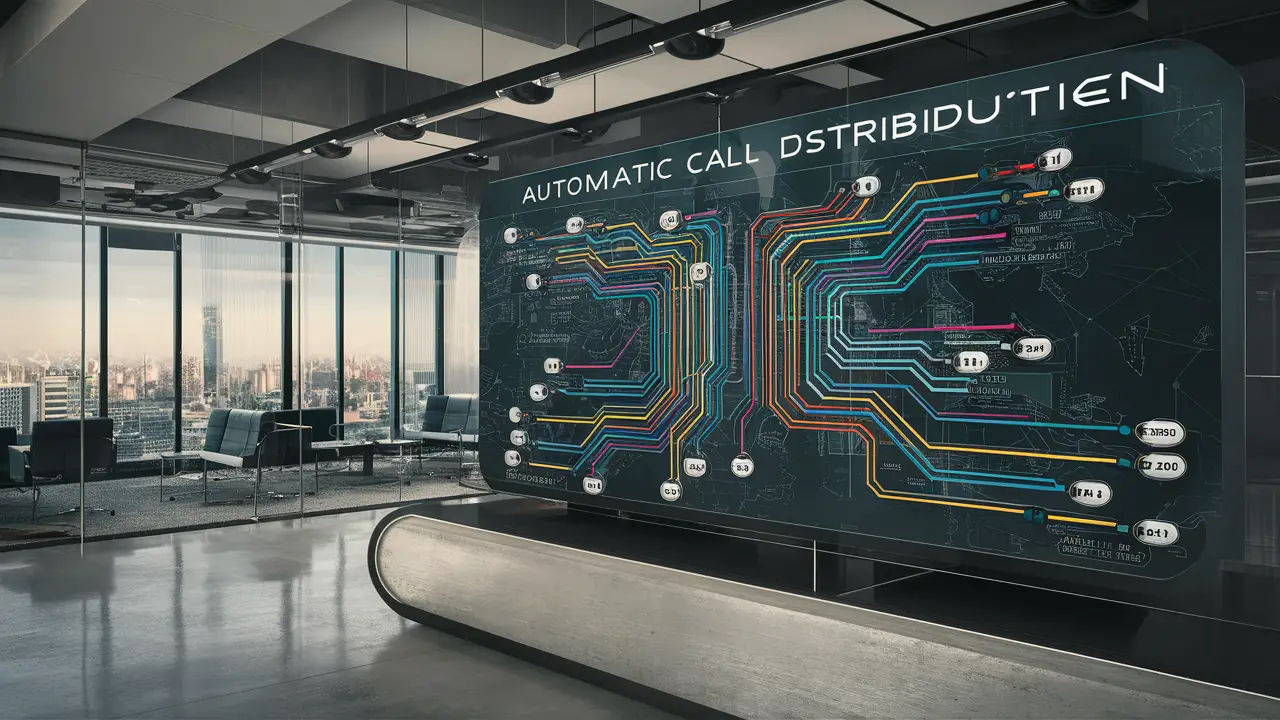
Introduction to AI in Call Distribution
Have you ever thought about how businesses handle countless phone calls and still manage to connect you with the right person quickly? What if you could discover how artificial intelligence is transforming these systems to be even more efficient? In today’s fast-paced world, these questions matter more than ever as we strive to improve customer service.
This article is here to show you how AI can take call distribution systems to the next level, making customer experiences smoother and faster. We’ll start by breaking down the basics of automatic call distribution, then explain why Java and Spring are the perfect match for these systems. Plus, you’ll get to see a real-life example of how an AI-powered ACD works using Java and Spring. With insights from **byrodrigo.dev**, you’ll be ready to boost your company’s call handling like never before.
 What is Automatic Call Distribution?
What is Automatic Call Distribution?
Imagine calling a customer service line and getting help quickly without having to go through tons of options. That’s what Automatic Call Distribution (ACD) does. It’s a system that makes sure your call goes to the right person or department fast, improving your experience.
ACD uses smart rules to manage calls. It can send your call to an agent based on their skills, how busy they are, or your past interactions with the company. This smart routing means less waiting for you and better use of agents’ time.
Think about a busy call center where many customers are calling for help. Without ACD, calls might be answered randomly, making customers unhappy and agents stressed. But with ACD, calls can be prioritized, so urgent issues are handled first. It’s amazing how this technology makes everything work so smoothly!
ACD systems often work with customer relationship management (CRM) tools. This integration gives agents quick access to your information, creating a personalized experience where agents know your history and preferences. In today’s competitive world, this kind of efficiency is crucial for keeping customers happy.
Why Use Java and Spring for ACD Systems?
Building an Automatic Call Distribution (ACD) system can seem complex, but choosing the right tools makes a big difference. Java and Spring are popular choices, and here’s why they stand out.
- Platform Independence: Java runs on any device with a Java Virtual Machine (JVM). This means your ACD system can work smoothly on different setups, whether it’s a server, a computer, or a mobile device. This flexibility ensures that your system performs well, no matter where it’s deployed.
- Spring Framework Benefits: With Spring, Java development becomes easier. Its features like dependency injection and aspect-oriented programming make the code clean and manageable. For instance, if you need to update your ACD system quickly, Spring helps you do it without much hassle.
- Strong Community Support: Java has a huge community. This means if you get stuck, there are plenty of resources and experts to help you out. Whether it’s forums, guides, or tutorials, support is always available to solve problems quickly.
- Scalability: As call volumes grow, your ACD system needs to keep up. Java is great at handling this growth. It ensures the system runs efficiently even when the number of calls suddenly spikes, keeping your customers happy.
- Easy Integration: Java and Spring can easily connect with other technologies, like databases and messaging systems. This capability is vital for ACD systems because they often need to access and share data with other services to manage calls effectively.
In short, using Java and Spring for your ACD system makes it strong and ready for the future. Their features help create a reliable and adaptable call management solution that grows with your needs.
Integrating AI with ACD: How Does It Work?
Imagine a busy call center getting flooded with customer calls. It sounds chaotic, right? But with AI technology, managing these calls can become much smoother and more efficient. Let’s talk about how AI can supercharge Automatic Call Distribution (ACD) systems.
First up, the power of data. ACD systems have loads of information about calls and customer interactions. When you bring AI into the mix, it can look at this data in new ways. For example, AI can spot patterns—like when the most calls happen—and help plan better staffing. Picture knowing exactly when you’ll need extra hands on deck, so customers aren’t left waiting around.
Next, think about how AI can actually understand what a customer is saying. This is thanks to something called natural language processing (NLP). With NLP, when a customer calls saying, “I’m having trouble with my order,” the AI gets it and sends the call straight to someone who can help. No more pushing buttons or listening to long menus. It makes the whole experience quicker and friendlier for the caller.
AI doesn’t just stop at understanding; it can also make smart choices on the fly. If one agent is swamped with calls, AI can reroute new calls to other agents who are free. This way, everyone gets help faster, and agents don’t get overwhelmed.
And here’s where it gets really cool: AI actually learns and gets better over time. It picks up on what works and what doesn’t, and constantly improves. Companies can keep an eye on how the system is doing and tweak it for the best results. This means the ACD system is always getting smarter, which is a big win for businesses and customers alike.
For developers using platforms like Java and Spring, integrating AI into ACD systems is not just doable, but it’s a chance to build something really effective. These tools offer a solid base to work with AI features, making it easier to create systems that actually work well in the real world.
In short, adding AI to ACD systems isn’t just about being fancy with tech. It’s about making the whole call experience better for everyone. Whether it’s quicker responses or more accurate routing, AI can make a real difference in customer service. And that’s something any business can get behind.
 Key Components for Building an AI-Driven ACD
Key Components for Building an AI-Driven ACD
Creating an AI-driven Automatic Call Distribution (ACD) system can transform how calls are handled in a call center. Key components come together to improve both customer and agent experiences. Here’s a breakdown of what you need to know:
- Organizing Data: The heart of an AI ACD system is its data. Think of call logs, customer interactions, and how agents perform. Using databases like MySQL, you can keep data organized. Remember, clean data is crucial. It ensures that AI can analyze it accurately.
- Using Machine Learning: Machine learning gives the ACD system its brainpower. By analyzing past call trends, it predicts things like call volumes. This helps in figuring out the best way to route calls. Tools like TensorFlow can be used to develop these smart models.
- Understanding Speech with NLP: To really get what a customer wants, the system uses Natural Language Processing (NLP). This tech helps the AI understand speech, directing calls to the right agent. Libraries like Apache OpenNLP can be integrated to make this happen.
- Easy Integration: The ACD system should talk to other platforms, like CRMs. Think of it like connecting the dots. Using RESTful APIs, you can ensure that all systems share data smoothly. This means agents can access customer info quickly, providing better service.
- User-Friendly Interface: Agents need an easy-to-use interface. Using technologies like React, you can build dashboards that show call statuses and agent workloads. This helps agents manage their time well, which in turn, makes customers happier.
These elements are essential in building a smart ACD system. By focusing on these, you’re setting up your call center for success with intelligent call handling. Remember, the right tools can greatly enhance the efficiency and capability of your system.
How to Implement AI features using Java and Spring?
Building AI features into your Automatic Call Distribution (ACD) system using Java and Spring can greatly enhance how your system handles calls. Let’s break it down into simple steps, using some powerful tools to make your call center smarter and more efficient.
Start with Spring Boot. It’s a fantastic tool that makes setting up new applications fast and easy. Imagine creating a system that can automatically direct calls to the right person based on what the caller needs. Spring Boot helps you build the backbone of this system, letting you focus on making it smarter with AI.
To understand what callers are saying, introduce some natural language processing tools like Apache OpenNLP or Stanford NLP. These tools help your system figure out the intent behind a caller’s words. For instance, if someone calls to report an issue, the AI can recognize this request and route the call to a support agent immediately.
For predicting call volumes or managing workloads, consider TensorFlow or Weka. These machine learning tools analyze past call data to learn patterns. This means your system can predict when call volumes will spike and adjust resources accordingly, like scheduling more agents during busy times.
Don’t overlook the importance of managing your call data effectively. Use Spring Data JPA to handle database operations. This ensures all call records and interactions are stored safely, and can be accessed whenever needed.
Finally, for seamless communication between different parts of your system, introduce a message broker like RabbitMQ or Apache Kafka. These tools ensure that messages, like routing information or call updates, are delivered quickly and reliably. This is crucial for maintaining a smooth call experience.
By combining these technologies, you create an ACD system that’s not just automated but intelligently responsive to customer needs. This leads to happier customers and a more efficient call center.
Overcoming Challenges in Implementing AI-Driven Call Distribution
Establishing an AI-powered Automatic Call Distribution (ACD) system can indeed seem daunting; however, success lies in effectively identifying and addressing key challenges. Here’s a deeper dive into the obstacles you might face and how to tackle them.
- Data Quality Matters: Think of AI as a student: if it learns from flawed information, it will produce incorrect results. Clean and accurate data is essential for effective call routing. Implement a robust process for data cleaning and validation, utilizing automated scripts to regularly audit and rectify anomalies in your datasets. Additionally, consider employing a basic NLP model with OpenNLP to classify call intents, ensuring more precise routing based on customer inquiries.
- Integration Complexity: The integration of AI into existing systems can often feel like fitting a square peg into a round hole. To simplify this, decompose the process into manageable components and utilize well-defined APIs for smooth communication between system parts. For example, while integrating Apache OpenNLP for natural language processing, ensure your API can accommodate various data formats and error responses, enhancing debugging and logging for better traceability.
- Continuous Learning and Improvement: Your AI must adapt to evolving user needs. Establish a robust feedback loop that collects user insights and system performance metrics regularly. Leverage this data to refine and retrain your AI models. For instance, you can implement a simple predictive model using TensorFlow or Weka to forecast call volumes based on historical data, allowing proactive adjustments to your routing algorithms.
- Scalability in Handling Growth: As your business expands, so will your call volume. Design your ACD system to scale effortlessly. Consider utilizing cloud solutions like AWS or Azure for elastic resource management and implementing load balancing to distribute calls evenly across your agent pool. This ensures robust performance, even during peak times.
- Empower Your Team Through Training: An advanced AI system is futile if your team doesn’t possess the skills to utilize it effectively. Develop comprehensive training programs that cover the intricacies of AI-driven call distribution. Incorporate hands-on sessions using case studies from companies that have successfully integrated AI in their ACD systems to demonstrate the practical impact and benefits of these technologies.
 Code Example: Java and Spring for AI-Powered ACD
Code Example: Java and Spring for AI-Powered ACD
- In this section, we’ll walk through a practical example of using AI with an Automatic Call Distribution (ACD) system. We’ll use Java and Spring to create a simple application that handles incoming calls and routes them to the right agent based on what the customer needs.
- Imagine a typical situation where a customer calls a company. They might say something like, “I need help with my order,” or “Can I talk to sales?” Our goal is to automatically figure out what the customer wants and connect them to the right person.
- To get started, we’ll use the Spring Boot framework. This makes it easy to create web applications in Java. You’ll also need the Apache OpenNLP library, which helps us understand human language.
- Here’s a simple setup for your project:
dependencies {
implementation 'org.springframework.boot:spring-boot-starter-web'
implementation 'org.apache.opennlp:opennlp-tools:1.9.3'
}
- Next, let’s create a controller to manage the calls. This part of the code listens for incoming requests and decides what to do with them:
import org.springframework.web.bind.annotation.*;
import org.apache.opennlp.tools.langdetect.LanguageDetectorME;
import org.apache.opennlp.tools.langdetect.LanguageDetectorModel;
import org.apache.opennlp.tools.util.InputStream;
import org.apache.opennlp.tools.util.Span;
@RestController@RequestMapping("/api/calls")
public class CallController {
@PostMapping("/route")
public String routeCall(@RequestBody CallRequest request) {
String customerInput = request.getInput();
String intent = determineIntent(customerInput);
return routeToAgent(intent);
}
private String determineIntent(String input) {
if (input.toLowerCase().contains("support")) {
return "support";
} else if (input.toLowerCase().contains("sales")) {
return "sales";
}
return "general";
}
private String routeToAgent(String intent) {
switch (intent) {
case "support": return "Routing to Support Agent.";
case "sales": return "Routing to Sales Agent.";
default: return "Routing to General Agent.";
}
}
}
- In this code, the routeCall method processes incoming customer input. It uses determineIntent to understand what the customer wants. Based on this, the system can connect the customer to the right agent, like a support or sales representative.
- For this to work, we need a simple class to handle the call data:
public class CallRequest {private String input; public String getInput() {
return input;
}
public void setInput(String input) {
this.input = input;
}
}
- This class just holds the words spoken by the customer. It’s straightforward but essential for processing the call.
- To see this in action, you can send a POST request to /api/calls/route. Include a JSON body like this:
{"input": "I need help with my order"}
- The system reads the input, understands it, and responds with something like:
Routing to Support Agent.
- This example shows how you can build a simple but effective ACD system using Java and Spring. By integrating AI, you can make your call routing smarter and more efficient, leading to better service and happier customers.
Conclusion and Next Steps
- You’ve just explored how artificial intelligence can transform Automatic Call Distribution (ACD) systems using Java and Spring. By integrating AI, you can enhance call handling efficiency and boost customer satisfaction, paving the way for smarter call routing solutions in your business.
- Over at byrodrigo.dev, you’ll find a treasure trove of resources that delve into using cutting-edge technologies like AI in software development. This platform is a great ally in helping you build robust and efficient ACD systems tailored to your unique requirements.
- Now, it’s time to put your newfound knowledge into action. What steps are you considering to incorporate AI into your current systems? How can you refine your ACD solutions based on customer input? Stay curious and proactive—there’s always more to explore in the exciting world of AI-powered technologies!






